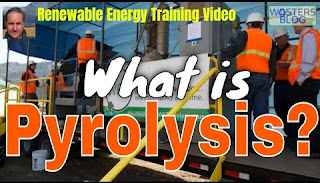In this video we will explain the definition of this process, which is used to extract energy from waste.
The non-technical answer is that pyrolysis is known to all of us in its initial stages, because it is what we can see taking place, during cooking.
Frying, baking, toasting and roasting, are all, to a varying degree “pyrolysis”. But, good cooks don’t take pyrolysis to its final stage, which is the production of char. “Char” as in burnt food!
Now for the scientific definition!
Pyrolysis is the thermal decomposition of a substance in a non-reactive atmosphere at high temperatures.
An external heat-source is applied to maintain a temperature, which is typically in the range 300 to 850 Degrees Centigrade for Municipal Solid Waste, (which is also known as household and commercial waste).
The output from the pyrolysis process is a solid residue and a “synthetic” gas, which is known as Syngas.
Many people refer to the solid residue as char. The char from the pyrolysis of MSW is a combination of non-combustible materials from the MSW, and carbon.
The syngas is comprised of a number of gases which are either combustible or non-combustible.
These mixture of gases in syngas include: Carbon Monoxide, Hydrogen, Methane, and, other Volatile Organic Carbon compounds.
Some of the condensed VOCs which result are oils, waxes, and tars. Once they have been cooled to normal temperatures.
Pyrolysis can be used to degrade fossil fuel based chemicals, but, for the purpose of this article we are solely referring to its use in the treatment of renewable organic matter.
The hydrogen and methane present are immediately available as a gas fuel.
Volatile Organic Carbon compounds in the syngas can also be cooled (if necessary), to result in a liquid fuel which, when the source is MSW, is usually classed as being a renewable fuel.
This is often referred to as anhydrous pyrolysis.
This being the heating of a solid organic material in the required temperature range, without oxygen.
There is a distinction between anhydrous pyrolysis and hydrous pyrolysis which occurs where steam is present.
The anhydrous pyrolysis of wood results in charcoal (char).
Did you ever watch a piece of coal, or wood, as it descends into the hottest part of a fire and burns?
As it heats up, there is a short period when it is often possible to see small gas jets pouring out of the recently added logs, lit by flame intermittently at first and then become red, and orange-flamed hot embers.
All the while, the volatile gaseous compounds in the coal or wood in any ordinary fire are pouring out of the wood and only once the flames have gone, does the wood come into contact with oxygen in the air, char is further burnt (oxidized) and, in an ordinary fire, where plenty of air is present, a powdery ash is produced.
Anhydrous pyrolysis is different, because there is, by definition, no air so, there is no oxygen present, with the result that so the remaining non-volatile carbon forms charcoal, and not ash.
Hydrous pyrolysis, using water can transform the waste matter into a liquid, with many similarities to a light crude oil.
There are companies that offer pyrolysis equipment that have developed their own “black box” pyrolysis systems, and some of those have optimized them by applying a vacuum to the process.
This lowers the boiling point, saving fuel, but also reducing or avoiding, some of the troublesome unwanted toxic chemical reactions.
Finally, before we end this video, there is a similar heat treatment process known as "Gasification". Gasification is also a heat treatment process.
It is essentially the same as pyrolysis except that a certain amount of oxygen is present during gasification to allow partial oxidation, producing “producer gas”:
Carbon Monoxide, Hydrogen, Methane in quantity, depending on the gasification temperature of the process the quantity of gas produced which contains methane varies.
We hope that you found this video useful, and if so, please "Like", "Share" and "Subscribe".
_________________________________
Watch this video on YouTube here:
https://youtu.be/rDMhS_TJAg4
_________________________________
Creative Commons Image Attribution:
This presentation contains images that were used under a Creative Commons License. Click here to see the full list of images and attributions:
https://link.attribute.to/cc/504585
_________________________________
For the full article visit: https://anaerobic-digestion.com/what-is-pyrolysis-pros-and-cons/
